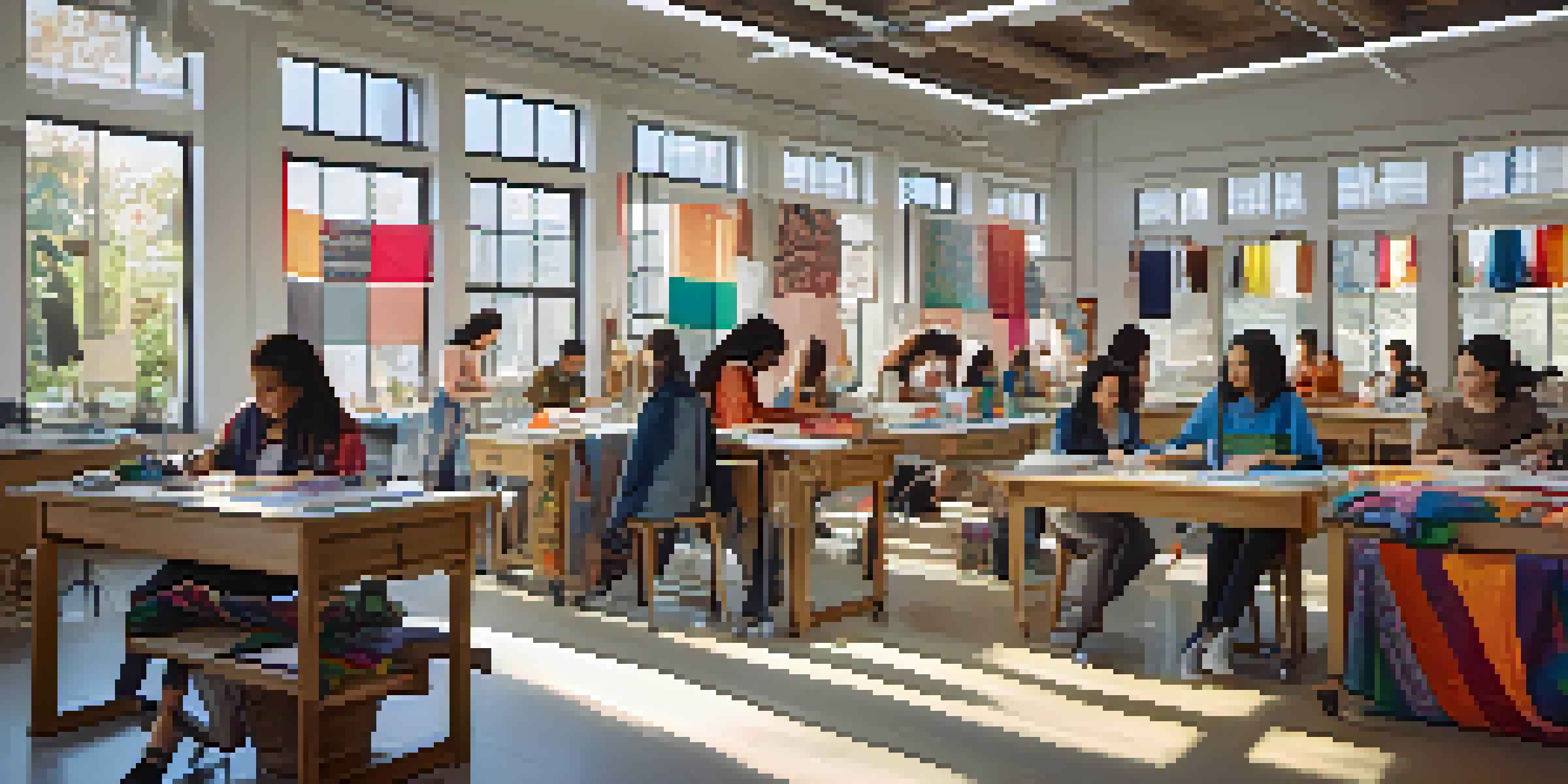Global Perspectives in Fashion Education: A Cultural Exchange

Understanding Cultural Exchange in Fashion Education
Cultural exchange in fashion education refers to the sharing of ideas, techniques, and practices between different cultures to enrich learning experiences. By incorporating diverse perspectives, students gain a broader understanding of fashion beyond their local context. This collaborative approach fosters creativity and innovation, allowing students to draw inspiration from a variety of cultural backgrounds.
Fashion is about dreaming and making other people dream. It's about the way we express ourselves and our culture.
For instance, a student from Japan might introduce traditional kimono-making techniques to a class in Italy, sparking a dialogue about fabric use and design principles. Such exchanges not only enhance technical skills but also deepen appreciation for the cultural significance behind each garment. Ultimately, this interconnectedness cultivates a more inclusive and dynamic fashion industry.
Moreover, as students engage with global practices, they develop critical thinking skills that prepare them for the complexities of a multicultural marketplace. By learning to navigate different cultural narratives, they become more adept at creating fashion that resonates with a diverse audience. This prepares them to be more versatile and innovative in their future careers.
The Role of International Collaborations in Fashion Education
International collaborations play a vital role in enhancing fashion education by providing students with firsthand exposure to global trends and practices. Programs that encourage students to study abroad or participate in exchange programs allow them to immerse themselves in different fashion cultures. These experiences can be transformative, providing insights that are often missed in traditional classroom settings.

For example, a partnership between fashion schools in France and Brazil can lead to joint projects where students explore the intersection of European and South American styles. Such initiatives not only foster creativity but also build networks that can be beneficial for students in their future careers. These connections often lead to unique design opportunities that stem from shared experiences.
Cultural Exchange Enriches Education
Sharing diverse cultural practices in fashion education fosters creativity and innovation among students.
Additionally, these collaborations often involve industry professionals who bring their expertise into the classroom. Guest lectures, workshops, and mentorship programs create a rich learning environment where students can learn from the best in the field. This blend of academic and real-world experience is invaluable in preparing students for the fast-paced fashion industry.
Incorporating Local Traditions into Global Education
While global perspectives are essential, it's equally important to honor and incorporate local traditions in fashion education. By blending local craftsmanship with global techniques, students can create truly unique designs that reflect their cultural heritage. This approach not only preserves traditional practices but also elevates them to an international stage.
The beauty of fashion is that it speaks to everyone, transcending borders and cultures.
For instance, a student from India might integrate local embroidery techniques into contemporary fashion designs, showcasing the rich history of their culture. This not only adds depth to their work but also allows for a dialogue between cultures, where traditional methods are appreciated in new contexts. Such innovations highlight the importance of cultural pride in a globalized world.
Furthermore, by emphasizing local traditions, fashion education can help students understand the socio-economic impact of their work. They can learn how to promote sustainable practices that benefit local artisans and communities, making their designs not just aesthetically pleasing but also socially responsible. This awareness is crucial in an industry that often grapples with ethical dilemmas.
The Importance of Diversity in Fashion Education
Diversity in fashion education enriches the learning environment by introducing a variety of perspectives and experiences. Students from different backgrounds contribute unique insights that can challenge conventional thinking and inspire new ideas. This diversity is not just beneficial for creative growth; it also prepares students to work in an increasingly globalized industry.
For instance, a diverse classroom may include students from various ethnicities, genders, and socioeconomic backgrounds, each bringing their own narratives to the table. This melting pot of experiences encourages collaboration and fosters empathy, essential skills for designers aiming to create inclusive fashion. It also helps students recognize and address biases within the industry.
Diversity Prepares for Global Industry
A diverse learning environment equips students with the skills needed to address the complexities of a globalized fashion market.
Moreover, as the fashion industry continues to evolve, having a diverse education equips students with the understanding needed to cater to a broad audience. This preparation is vital for future success, as fashion is no longer a monolithic field but a reflection of the diverse societies we live in. Embracing diversity helps create fashion that speaks to everyone.
Technology's Role in Facilitating Cultural Exchange
In today's digital age, technology plays a crucial role in facilitating cultural exchange in fashion education. Online platforms can connect students and educators from around the world, allowing them to collaborate, share ideas, and learn from each other regardless of geographical barriers. Virtual classrooms and workshops have become valuable tools in this global exchange.
For example, students can participate in webinars with industry experts from different countries, gaining insights into international trends and practices. Social media also serves as a powerful medium for showcasing diverse fashion styles and cultural narratives, making it easier for students to draw inspiration from a global pool of creativity. This interconnectedness helps foster a sense of community among aspiring designers.
Additionally, technology enables students to conduct research and access resources that were previously unavailable to them. Online databases, virtual museums, and fashion archives provide a wealth of information that can enhance their understanding of global fashion history. As students tap into these resources, they become better equipped to create innovative designs that reflect a fusion of influences.
Challenges in Implementing Global Perspectives in Education
Despite the numerous benefits, implementing global perspectives in fashion education can pose challenges. One significant hurdle is the disparity in resources between institutions, particularly in developing countries. Limited access to materials, technology, and experienced educators can hinder students' ability to fully participate in global exchanges.
Additionally, there may be cultural barriers that affect how students perceive and engage with global practices. Some students may feel intimidated by the dominance of certain fashion capitals, which can stifle creativity and discourage participation in international dialogues. Addressing these concerns requires a concerted effort from educators to create an inclusive environment that encourages all voices to be heard.
Technology Bridges Cultural Gaps
Digital platforms facilitate collaboration and access to global fashion insights, enhancing students' learning experiences.
Moreover, balancing local traditions with global influences can be a delicate task. While it's important for students to embrace innovation, they must also understand and appreciate the value of their own cultural heritage. Finding this equilibrium is crucial in ensuring that fashion education remains relevant and meaningful in a rapidly changing global landscape.
The Future of Fashion Education Through Cultural Exchange
Looking ahead, the future of fashion education seems promising as cultural exchange continues to gain traction. As more institutions recognize the value of global perspectives, we can expect to see an increase in collaborative programs and initiatives aimed at fostering diversity and inclusion. This evolution will not only benefit students but also enrich the fashion industry as a whole.
With the rise of sustainability and ethical fashion, there is a growing emphasis on teaching students about the cultural significance of their work. By understanding the stories behind materials and techniques, future designers can create meaningful pieces that resonate with consumers. This shift towards responsible fashion is a direct result of the cultural exchanges taking place in educational settings.

Ultimately, as fashion education evolves, it will play a pivotal role in shaping a more inclusive and diverse industry. By embracing global perspectives and fostering cultural exchange, we can cultivate a new generation of designers who are not only skilled but also socially conscious and culturally aware. The future of fashion is not just about trends; it's about understanding and celebrating the richness of our global tapestry.